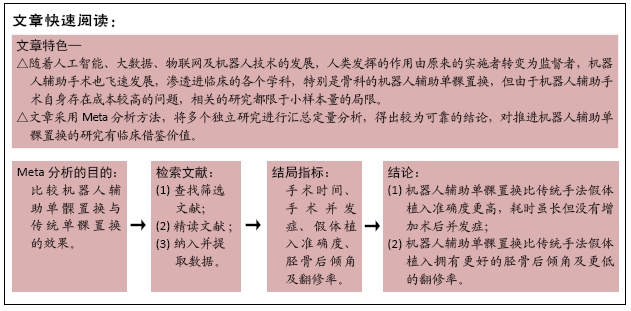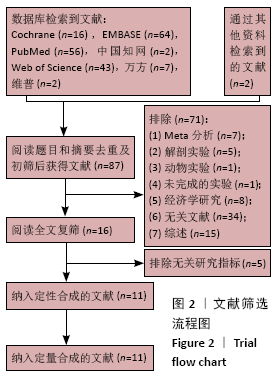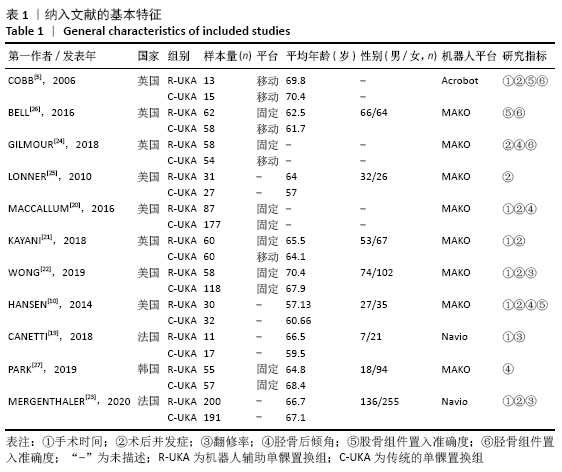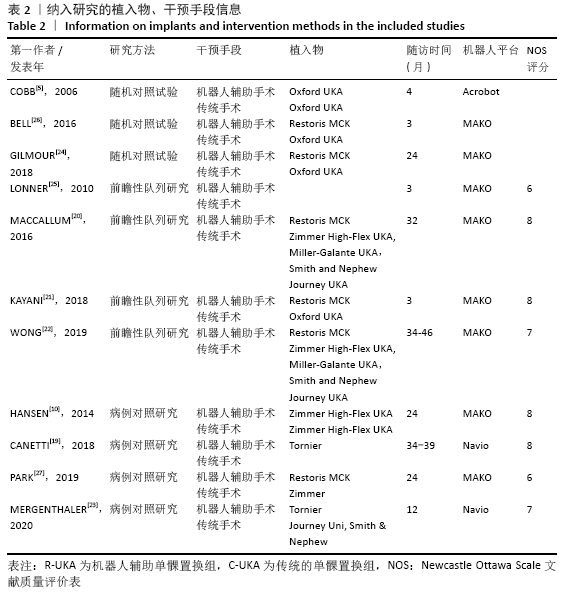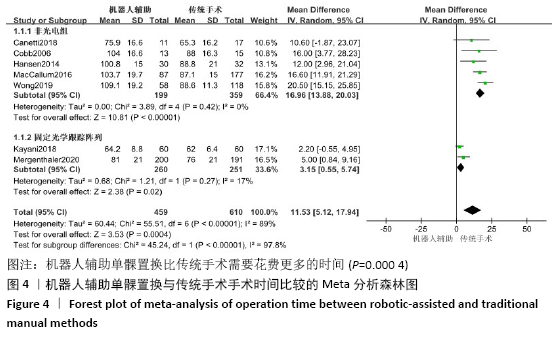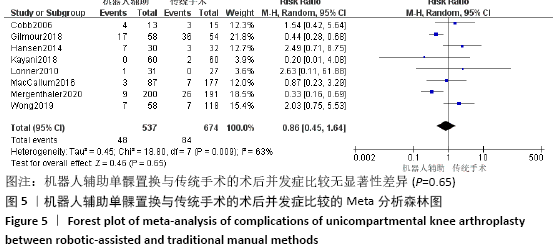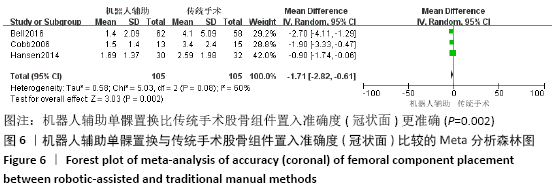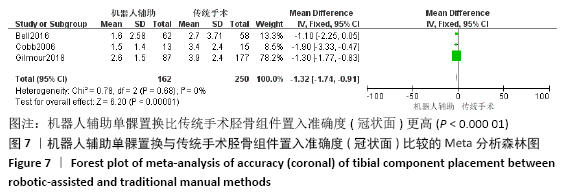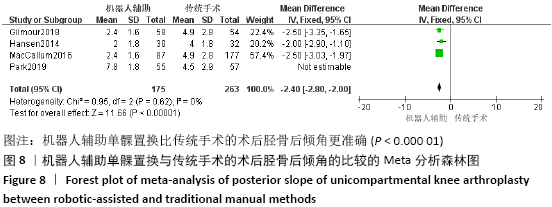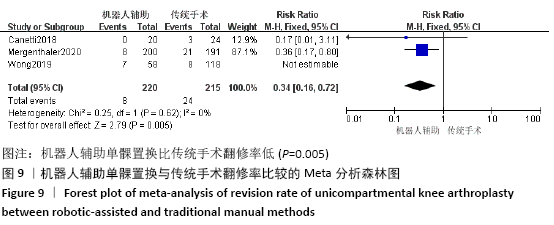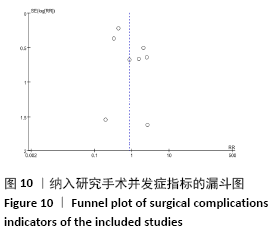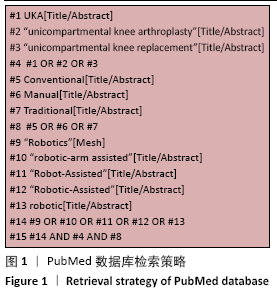[1] ZHANG F, LI H, BA Z, et al. Robotic arm-assisted vs conventional unicompartmental knee arthroplasty: a meta-analysis of the effects on clinical outcomes. Medicine. 2019;98(35):e16968.
[2] FU J, WANG Y, LI X, et al. Robot-assisted vs. conventional unicompartmental knee arthroplasty: systematic review and meta-analysis. Orthopade. 2018;47(12): 1009-1017.
[3] VANDERLIST JP, CHAWLA H, PEARLE AD. Robotic-assisted knee arthroplasty: an overview. Am J Orthop. 2016;45(4): 202-211.
[4] 高阳阳,车先达,韩鹏飞,等.机器人辅助与传统手法行单髁置换效果的Meta分析[J].中国组织工程研究,2019,23(36): 5889-5895.
[5] COBB J, HENCKEL J, GOMES P, et al. Hands-on robotic unicompartmental knee replacement. A prospective, randomised controlled study of the Acrobot system. J Bone oint Surg (Series B). 2006;88(2):188-197.
[6] 蔡尚欢,宋永伟,曹向阳,等.骨科机器人应用现状与研究进展[J].山东医药, 2018,58(44):90-93.
[7] 赵燕鹏,唐佩福.骨科机器人及导航技术研究进展[J].中国矫形外科杂志,2016, 24(3):242-246.
[8] 韩晓光,刘亚军,范明星,等.骨科手术机器人技术发展及临床应用[J].科技导报,2017,35(10):19-25.
[9] RODRIGUEZ F, HARRIS S, JAKOPEC M, et al. Robotic clinical trials of uni-condylar arthroplasty. Int J Med Robot. 2005;1(4): 20-28.
[10] HANSEN DC, KUSUMA SK, PALMER RM, et al. Robotic guidance does not improve component position or short-term outcome in medial unicompartmental knee arthroplasty. J Arthroplasty. 2014;29(9):1784-1789.
[11] GAUDIANI MA, SAMUEL LT, KAMATH AF, et al. Robotic-assisted versus manual unicompartmental knee arthroplasty: contemporary systematic review and meta-analysis of early functional outcomes. J Knee Surg. 2020. doi: 10.1055/s-0040-1701455.
[12] BATAILLER C, WHITE N, RANALDI FM, et al. Improved implant position and lower revision rate with robotic-assisted unicompartmental knee arthroplasty. Knee Surg Sports Traumatol Arthrosc. 2019;27(4):1232-1240.
[13] CHIN BZ, TAN SS, CHUA KC, et al. Robot-assisted versus conventional total and unicompartmental knee arthroplasty: a meta-analysis of radiological and functional outcomes. J Knee Surg. 2020. doi: 10.1055/s-0040-1701440.
[14] VANDERLIST JP, CHAWLA H, JOSKOWICZ L, et al. Current state of computer navigation and robotics in unicompartmental and total knee arthroplasty: a systematic review with meta-analysis. Knee Surg Sports Traumatol Arthrosc. 2016;24(11):3482-3495.
[15] KARUNARATNE S, DUAN M, PAPPAS E, et al. The effectiveness of robotic hip and knee arthroplasty on patient-reported outcomes: a systematic review and meta-analysis. Int Orthop. 2019;43(6):1283-1295.
[16] 中华医学会骨科学分会关节外科学组.骨关节炎诊疗指南(2018年版)[J].中华骨科杂志,2018,38(12):705-715.
[17] 戴雪松,宓云峰,熊炎,等.活动与固定平台的单髁假体置换治疗膝关节内侧间室骨关节炎[J]. 中华骨科杂志,2015, 35(7):691-698.
[18] ANDREAS S. Critical evaluation of the Newcastle-Ottawa scale for the assessment of the quality of nonrandomized studies in meta-analyses. Eur J Epidemiol. 2010; 25(9):603-605.
[19] CANETTI R, BATAILLER C, BANKHEAD C, et al. Faster return to sport after robotic-assisted lateral unicompartmental knee arthroplasty: a comparative study. Arch Orthop Trauma Surg. 2018;138(12):1765-1771.
[20] MACCALLUM KP, DANOFF JR, GELLER JA. Tibial baseplate positioning in robotic-assisted and conventional unicompartmental knee arthroplasty. Eur J Orthop Surg Traumatol. 2016;26(1):93-98.
[21] KAYANI B, KONAN S, PIETRZAK JR, et al. The learning curve associated with robotic-arm assisted unicompartmental knee arthroplasty: a prospective cohort study. Bone Joint J. 2018;100(8):1033-1042.
[22] WONG J, MURTAUGH T, LAKRA A, et al. Robotic-assisted unicompartmental knee replacement offers no early advantage over conventional unicompartmental knee replacement. Knee Surg Sports Traumatol Arthrosc. 2019;27(7):2303-2308.
[23] MERGENTHALER G, BATAILLER C, LORDING T, et al. Is robotic-assisted unicompartmental knee arthroplasty a safe procedure? A case control study. Knee Surg Sports Traumatol Arthrosc. 2020. doi: 10.1007/s00167-020-06051-z.
[24] GILMOUR A, MACLEAN AD, ROWE PJ, et al. Robotic-arm–assisted vs conventional unicompartmental knee arthroplasty. the 2-year clinical outcomes of a randomized controlled trial. J Arthroplasty. 2018;33(7): 109-115.
[25] LONNER JH, JOHN TK, CONDITT MA. Robotic arm-assisted uka improves tibial component alignment: a pilot study. Clin Orthop Relat Res. 2010;468(1):141-146.
[26] BELL SW, ANTHONY I, JONES B, et al. Improved accuracy of component positioning with robotic-assisted unicompartmental knee arthroplasty: data from a prospective, randomized controlled study. J Bone Joint Surg Am. 2016;98(8):627-635.
[27] PARK KK, HAN CD, YANG IH, et al. Robot-assisted unicompartmental knee arthroplasty can reduce radiologic outliers compared to conventional techniques. PLoS One. 2019;14(12):e0225941.
[28] JULIE RS, PHILIP ER, PHILIP JR. Accuracy of a freehand sculpting tool for unicondylar knee replacement. Int J Med Robot. 2014; 10(2):162-169.
[29] ALI M, JOHANNES FP, BO L, et al. Assessment of accuracy of robotically assisted unicompartmental arthroplasty. Knee Surg Sports Traumatol Arthrosc. 2014; 22(8):1918-1925.
[30] CITAK M, SUERO EM, CITAK M, et al. Unicompartmental knee arthroplasty: is robotic technology more accurate than conventional technique? Knee. 2013;20(4): 268-271.
[31] MATSEN FA, GARBINI JL, SIDLES JA, et al. Robotic assistance in orthopaedic surgery. A proof of principle using distal femoral arthroplasty. Clin Orthop Relat Res. 1993; (296):178-186.
[32] IÑIGUEZ M, NEGRÍN R, DUBOY J, et al. Robot-assisted unicompartmental knee arthroplasty: increasing surgical accuracy? A Cadaveric Study. J Knee Surg. 2019. doi: 10.1055/s-0039-1698771.
[33] BARBADORO P, ENSINI A, LEARDINI A, et al. Tibial component alignment and risk of loosening in unicompartmental knee arthroplasty: a radiographic and radiostereometric study. Knee Surg Sports Traumatol Arthrosc. 2014;22(12):3157-3162.
[34] JEANYVES J, CYRIL B. Unicompartmental knee prosthesis implantation with a non-image-based navigation system: rationale, technique, case-control comparative study with a conventional instrumented implantation. Knee Surg Sports Traumatol Arthrosc. 2003;11(1):40-45.
[35] QIAN LM, JOSEPH DL, CHENG KC, et al. A Comparison between chinese and caucasian 3-dimensional bony morphometry in presimulated and postsimulated osteotomy for total knee arthroplasty. J Arthroplasty. 2017;32(9):2878-2886.
[36] MICHAEL EN, ANTHONY A, NELSON VG, et al. A comparison of mobile and fixed-bearing unicompartmental knee arthroplasty at a minimum 10-year follow-up. J Arthroplasty. 2018;33(6):1713-1718.
[37] MILLAR LJ, BANGER M, ROWE PJ, et al. O 017-A five-year follow up of gait in robotic assisted vs conventional unicompartmental knee arthroplasty. Gait Posture. 2018;65(1): 31-32.
[38] MOTESHAREI A, ROWE P, BLYTH M, et al. A comparison of gait one year post operation in an RCT of robotic UKA versus traditional Oxford UKA. Gait Posture. 2018;62:41-45.
[39] BLYTH MJ, ANTHONY I, ROWE P, et al. Robotic arm-assisted versus conventional unicompartmental knee arthroplasty: Exploratory secondary analysis of a randomised controlled trial. Bone Joint Res. 2017;6(11):631-639.
[40] RAJ KS. Outcomes of robotic arm-assisted unicompartmental knee arthroplasty. Am J Orthop. 2009;38(2 Suppl):20-22.
[41] JINNAH AH, AUGART MA, LARA DL, et al. Decreased time to return to work using robotic-assisted unicompartmental knee arthroplasty compared to conventional techniques. Surg Technol Int. 2018;32: 279-283.
[42] MOSCHETTI WE, KONOPKA JF, RUBASH HE, et al. Can robot-assisted unicompartmental knee arthroplasty be cost-effective? A Markov Decision Analysis. J Arthroplasty. 2016;31(4):759-765.
[43] NHERERA L, VERMA S, TRUEMAN P. MT1 cost-effectiveness of robotic-assisted unicompartmental knee arthroplasty (R-UKA)* compared to traditional unicompartmental knee arthroplasty (T-UKA). Value Health. 2019;22(2):S41.
[44] CLEMENT ND, DEEHAN DJ, PATTON JT. Corrigenda: Robot-assisted unicompartmental knee arthroplasty for patients with isolated medial compartment osteoarthritis is cost-effective: a Markov decision analysis. Bone Joint J. 2019;101(9): 1063-1070.
[45] YEROUSHALMI D, FENG J, NHERERA L, et al. Early economic analysis of robotic-assisted unicondylar knee arthroplasty may be cost effective in patients with end-stage osteoarthritis. J Knee Surg. 2020. doi: 10.1055/s-0040-1712088.
[46] LONNER JH, FILLINGHAM YA. Pros and cons: a balanced view of robotics in knee arthroplasty. J Arthroplasty. 2018;33(7): 2007-2013.
[47] 曹旭含,白子兴,孙承颐,等.机器人在骨科手术中应用的可靠性与提升空间[J].中国组织工程研究,2020,24(9):1416-1421.
|
